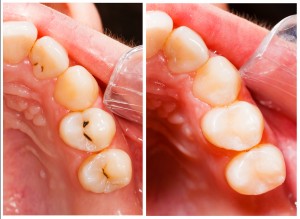 What the CDC says is this: “Dental sealants are thin coatings that when painted on the chewing surfaces of the back teeth (molars) can prevent cavities (tooth decay) for many years. Sealants protect the chewing surfaces from cavities by covering them with a protective shield that blocks out germs and food. Once applied, sealants protect against 80% of cavities for 2 years and continue to protect against 50% of cavities for up to 4 years.”
What the CDC says is this: “Dental sealants are thin coatings that when painted on the chewing surfaces of the back teeth (molars) can prevent cavities (tooth decay) for many years. Sealants protect the chewing surfaces from cavities by covering them with a protective shield that blocks out germs and food. Once applied, sealants protect against 80% of cavities for 2 years and continue to protect against 50% of cavities for up to 4 years.”
All that is pretty good news. But it’s important to know two key things:
- How sealants are different than fillings
- Why sealants are most commonly used on children’s teeth
Think of it this way: Fillings are forever. Well, not forever forever, but a pretty long time depending on the material used. Fillings are literally filling a hole in your tooth that has been caused by tooth decay. Sealants, on the other hand, are protecting vulnerable areas of your teeth so they don’t decay. Sealants are preventative. Fillings are restorative.
Sealants are for kids?
So why do dentists use sealants on children more commonly than adults? If you’ve been paying attention you can probably make an educated guess. Sealants, ideally, keep tooth decay from ever happening. So once a child’s permanent teeth come in, those teeth have a far better chance of keeping tooth decay away when a protective coating is used over the grooves within a tooth’s chewing surfaces.
Dentists have seen sealants still work up to 9 years after placement, but that’s no guarantee. Sealants are known to fall off, so your dentist should be checking them during dental exams. If you switch dentists, make sure your records go along with you because when a tooth loses its sealant, it’s more likely to get a cavity. Meanwhile, missing sealants are easy for any dentist to replace. So communication is key.
Seeing and feeling sealants
Sealant material is made to mimic the natural color of teeth, but there’s no such thing as a perfect match. Since the plastic film that is applied onto the surface of the tooth flows into its natural grooves and since the back teeth are the more common spots to use it in, it’s hard to notice when one has sealant on their teeth. Also, the material is hardened via ultraviolet light by the dentist who makes sure your bite is aligned. In other words, the whole process is one that helps everything blend in.
Nonetheless, some kids can feel where their teeth have been sealed. Over time, typically, they desensitize to it and have no issues.
Sealing the deal
When you speak to your dentist—we hope you do that—about whether sealants are right for you or your family, here are some things to discuss about the product and the process.
- Fluoride—If your water has fluoride, your teeth likely have stronger enamel. But sealants are protecting your teeth by keeping gunk out of the crevasses. If you think you or your child doesn’t need sealant because of your fluoride levels in the water, please consult with your dentist.
- Pain—There should be absolutely none! The tooth that’s getting the sealant will be cleaned, sometimes with a gel. The tooth is then rinsed and dried off so the sealant can be painted on the tooth.
- Age—Sealants are most commonly applied around the age of 6 on first molars and around the age of 12 for second molars. Your dentists recommendations for sealing teeth should involve your child’s age in addition to the tooth-in-question’s surface.







Leave a Reply